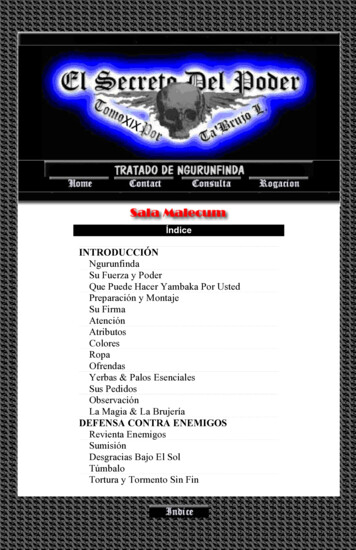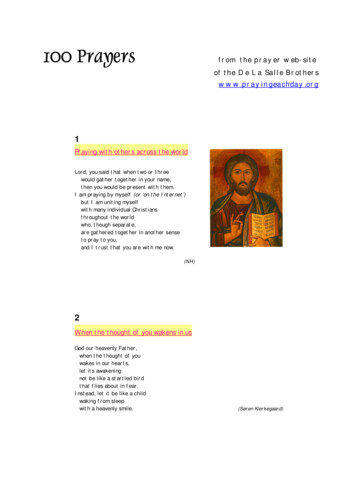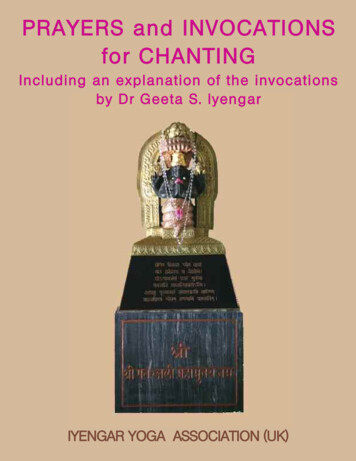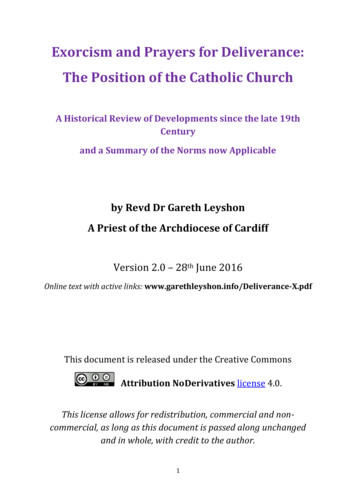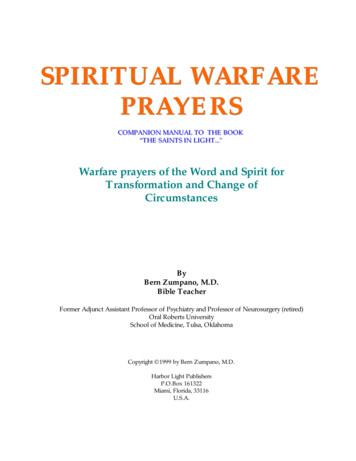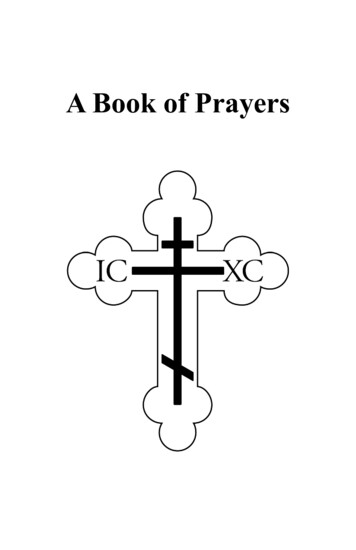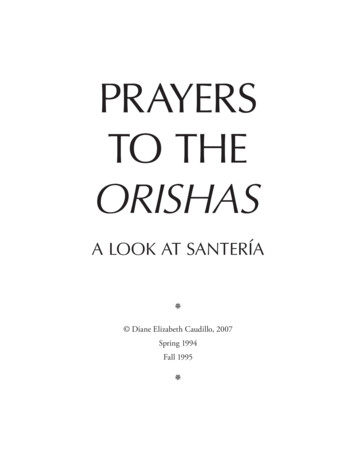
Transcription
PRAYERSTO THEORISHASA LOOK AT SANTERÍA Diane Elizabeth Caudillo, 2007Spring 1994Fall 1995
PRAYERS TO THE ORISHASIntroductionWho owns your head? This provocative question means a great deal to many people around theworld who practice a religion known as Santería, or alternatively (some people mind the previous name), LaRegla de Ocha. This tradition originates among the Yoruba people of West Africa, in the area of present-dayNigeria. A great percentage of the slaves who were brought to the New World were Yoruban— according toDavid Brown of Emory University, 500,000 Africans were taken into Cuba between 1800 and 1870, andone third were Yoruban or from Yoruban-influenced areas.1 According to Robert Farris Thompson, 40% ofall Africans abstracted from Africa came from the Kongo and Angola regions.2 This fact helps explain someof the traditions observable today in the United States, in the form of yard shows, bottle trees, words like“banjo”- “mbanja” and “goober” (peanut) - “mgooba”. Many popular dance and musical styles - the Charleston, jug bands, jazz - owe their origin to African ways preserved by the descendants of those Africans whosurvived the Middle Passage.While it seems that the main body of the Regla de Ocha tradition points to Yoruban ancestry, thepreceding information on the rich legacy of the Kongo traditions merits inclusion so that we do not forget the circumstances of this tradition’s prominent place in the New World. Today, la Fé (the Faith), orSantería, is essential to the national identity of Cuba, and practitioners live in Brazil, Panama, the Dominican Republic, the United States, Europe, and other countries. Also, in Haiti, one will see evidence of kinshipbetween Vodun and la Fé of Cuba. The Africans who were brought to the New World as slaves adapted theirtraditions to the new environment - the condition of slavery, and the codes noirs, which were an effort toseparate the spiritual and political leaders from their people and which forbade the practice of their religions;the new natural environment; and the mixing of African cultures with European cultures, which gave riseto the syncretized version of the Yoruban religion that has become Santería. The enslaved Africans gainedstrength to perservere and to resist through practicing their traditions. To paraphrase the words of Ifá priestFagbemi John Turpin, from a lecture in which he referred to the plight of these newly arrived Africans: fromthe moral, ethical and spiritual understanding gained from their sacred traditions, they gained the strength
and maturity to resist the Middle Passage. They took what they had left behind and what they found, andused these to destabilize the yoke.3As a final note of introduction to this discussion of Santería prayers to the orishas, I offer the following quote, which beautifully encompasses much of what I hope to make clear: Ashe, or aché, divination,deities, sacrifice, ceremony, chants, possession, and healing.“It is ritual which allows humans to traverse all the categories of being through the manipulationand communication of ashe. The various forms of divination allowed people to have access to theaccumulated wisdom of the deities and the dead as the paradigms for solving current problems.Offerings of food, objects, song, money, or the blood of animals in sacrifice all revivified theashe of the orisha and directed it toward specific ends. In ceremonial spirit possession, the linkbetween the orisha and its descendants became palpable as, in ceremonies held in its honor,the immaterial being came down from on high and took over the body of one of its children,communicating to the assembly in a visible, physical, human form. Last but not least, it is theashe in the priestess and the herbs, in the blood of the animal and the chants of praise andsupplication, that heals the sick and forestalls death in rituals of affliction.”4Mythological beginningsOlodumare is the Mother-Fatherdiscovered and yet to be discovered,achéfrom human kind and our doings.Yoruba religion, Olodumare, orand heavens, is at the top, folby the Egungun, or the ancestors;God, the original creator of all thingsachéby plants and animals, and finallyerarchy is merely a rough outline forthe complex cosmological foundations of theOlodumareorishasegungunhumansplants & animals“non-living” thingsachéwho remains somewhat remoteIn the hierarchy of beings inachéOlorún, owner of the skieslowed by the orishas, and nextnext come humans, followed“non-living” things. This hiunderstanding ideas concerningreligion. (Furthermore, this is a goodplace to note that within this short text, other explanations about the beliefs and practices of Santería maynot include the full diversity and richness of the tradition, which has variations in its practice from place to
place, and across time.)Surrounding and permeating everything is the spiritual force, energy, known as aché.5 All powers aremanifestations of this absolute and indefinable power.6 Olodumare sent the orishas to form the Earth and totake care of things there. Each one had responsibilities for creation before leaving heaven. Oduduwa (Odua)created the Earth and became the original ancestor of the Yoruba people. He began his work in Ile-Ife,which is accordingly regarded as a holy city.7 The orishas became the rivers and streams, the mountains andhills, and some notable trees of Yorubaland, as well as other natural principles and elements such as lightning, thunder, wind, sudden change, the ocean, and the crossroads.8Ifá: Philosophy and ethics of West AfricaIfá is the Yoruba system of cosmology, philosophy and divination, contained in a vast oral text. To performdivination, an Ifá priest, “father of the mysteries,” or babalawo, “casts a chain of eight halves of palm nutsor else sixteen separate nuts, and then reading the pattern of the cast, he marks the permutations on a traycovered with wood dust. Each permutation corresponds to an odú, or saying, of which there are 256. Toeach odu is attached a number of verses conveying a myth or story that points to the answer of the client’sproblem.”9 Through divination, babalawos can find out which orisha owns a person’s head.According to Ifá texts, two pantheons of supernatural powers compete for domination of the universe: the “400 supernatural powers of the right,” the orishas, who are benevolent toward humans, and the“200 supernatural powers of the left,” the ajogun, who are malevolent.10 Eshu is an aspect of Eleguá, who isone of the most powerful orishas. He is capable of changing his form at will, and acts as the impartial judgewho mediates between the two factions. To accomplish his diplomacy, he uses sacrifices that are offered byhumans who would otherwise be victims of the malevolent forces. Through the offering of sacrifices, human beings are able to resolve conflicts in the cosmos.11 Santeros act upon this principle when they feed theorishas who manifest themselves through possession; divination also reveals the need for specific sacrifices ofebo, an animal sacrifice, or of adimú, an offering of food.From Ifá comes Orí, the principle of predestiny, and the spiritual aspect of humans. Orí is also considered one of the orishas. The physical aspect of a human’s life is molded by Obatála. Before birth, humansselect for themselves Orí, (the inner or spiritual head), which determine whether they will have good fortune
on earth. Esè represents the principle of struggle and self-help: one must work to bring the potential of one’sOrí to bear.12 Iwàpèlé describes the concept of good character. From Ifá:“All good things of life that a man hasIf he lacks good character,They belong to someone else.ìwà, ìwà, is what we are searching for.”and:“Good character is the essence of religion.”13Honesty and patience are among the attributes of good character that are explicitly explained withinthe texts of Ifá. Fagbemi John Turpin (who was initiated in Nigeria as an Ifá priest), in his lecture “Ifa: TheWellspring of Orisha,” at the University Art Museum in Berkeley, spoke about the wisdom contained inthe texts of Ifá: Be truthful, and be righteous. From the scripture of Ifá: “Those who speak the truth are theones to whom the gods direct help.” Honesty describes energy as well as behavior. The philosophy does notcontain principles of absolute evil, original sin, or salvation. Rather, it contains the idea that we are all bornas living apostles of divine unity. We are wholly inclusive of the totality. (Be! Become!) We have all comefrom something. The ancestors, Egungun, of a family are celebrated at least once annually. Egun is the sacredterm for the pure, rareified spirit form of the ancestors, who are not limited to one’s own grandparents andother progenitors. Each of us is a blessed expression of a divine continuum. Turpin also said that the greattraditions speak one voice, ultimately. He mentioned some, such as early Egyptian, Bonpo (pre-BuddhistTibetan), and Hebraic, that shared some beliefs contained in Ifá: immortality of the soul, respect for elders,healing from nature, and the use of tonal values to effect transference. Finally, I think it important to notethat speaking as a priest of Ifá, Fagbemi John Turpin said that women are the underpinning of everythingthat has been accomplished in Africa.Another idea from Ifá that permeates both Yoruba and Santería culture is the belief that there was anancient covenant between humans and nature. We have seen that the orishas inhabit many aspects of nature, and the mutual respect implied by the covenant between humans and nature includes all “non-living”things as well. “The Yoruba believe that each object of nature has an ancient name that is used to communi
cate with it and to command it to do our will. The Yoruba base their use of spells, chants, and incantationsagainst any hman or nonhuman creature on this belief.”14The OrishasThe orishas symbolically represent aspects of the personality of the Divine, Olodumare. They aremessengers who reshape spirit into matter, and the embodiment of spiritual principles. Some of the orishasare human ancestors who became deities when they died. They are finite expressions of fundamental characteristics of existence.One may see candles with a representation of the Seven African Powers, or Las Siete Potencias Africanas. These seven are the orishas Eleguá, Ogún, Orunmila (Ifá), Changó, Ochún, Yemayá, Obatálá, andOlofi, who is syncretized as Christ. The spellings of their names may vary. The variations in details of namesand attributes of the orishas originates in slavery, and in the syncretization process. In addition, the geographical spread of Yoruba tradition in Africa has caused some variations. The program for a performanceof John Santos and the Machete Ensemble includes some of the lyrics that come from chants to the orishas,and some of them are translated. They explain: “It should be understood that since the colonial period, theYoruba language has undergone an intense transculturalization and creolization in the Carribean. For thisreason, the lyrics are often compilations from many different sources, and are usually difficult to translateliterally.”Each orisha has a number, symbol, color, and day of the week, that is sacred to it, as well as foodsand offerings they prefer. Through a complex divination procedure by a babalawo, those who are initiated toSantería find out for certain which orisha owns their head, and must then avoid the foods and behaviors thatdisagree with their orisha. An uninitiated devotee, aleyo, may find out from a santero who owns his or herhead, but not with the certainty that a babalawo can provide.In The Santería Experience, by Migene González-Wippler, the author recalls what María, her childhood teacher in Puerto Rico, told her: “If you know the orishas, you know everything. The earth teach youeverything, but you must pay your respects to her always, do foribale, so she will give you all her secrets. Andalways remember, the secrets of the earth are the secrets of the orishas.”15Eleguá, Eshù-Elégba, Ellegua
He is the owner of the crossroads, thresholds and opportunities, the trickster who teaches lessons.He wears a cap that is red on one side and black on the other, teaching that unless you go 360 around, youhave no right to generalize.16 He opens and closes all doors and paths. He is the divine messenger who carriesprayers to all the orishas, or doesn’t, if one does not show proper respect. He is the first orisha invoked in aceremony, and the first share of all offerings go to Elegua so that he will open up the path, and make thingsgo smoothly. His sacred number is 3, his sacred day is Monday, his colors are red and black and his emblemis a hooked staff. He is partial to cigars, corn and rum and enjoys gifts of these as well as of candles, toysand candies. These last two satisfy his childlike, playful qualities. He personifies the unpredictable elementof life. He was certainly present when we stood under the BART sign to sing songs to the orishas, (mostespecially to Oyá, the orisha who rules the passageways between life and death and who leads the dead, losMuertos, to the cemetery) during the Día de los Muertos celebration in San Francisco’s Mission District.Here is a rezo, or prayer, to Eleguá, sung with or without drums:Barasuayo omo ni Alaguana mama kenya irawo eBarasuayo omo ni Alaguana mama kenya irawo eO bara wayo, eke, Echu odaraOmo oni Alaguana mama kenya irawo eVital force that through length and breadth appears, child who separates fissures anddivides our pathway, do not cut the flow of kindness from me.17 Two more prayers:Ibarago moyubaIbarago moyubaIbarago moyuba Elegba Eshulona
O great one, I salute youO great one, I salute youO great one, I salute Eleggua, Eshu on the road Ago agoAgo agoAgo ile agoOpen up, open upOpen up, open upOpen up, ile, open up18 OgúnOgún, like Eleguá, is a warrior, and the god of war and iron. One source says
deities, sacrifice, ceremony, chants, possession, and healing. “It is ritual which allows humans to traverse all the categories of being through the manipulation and communication of ashe. The various forms of divination allowed people to have access to the

